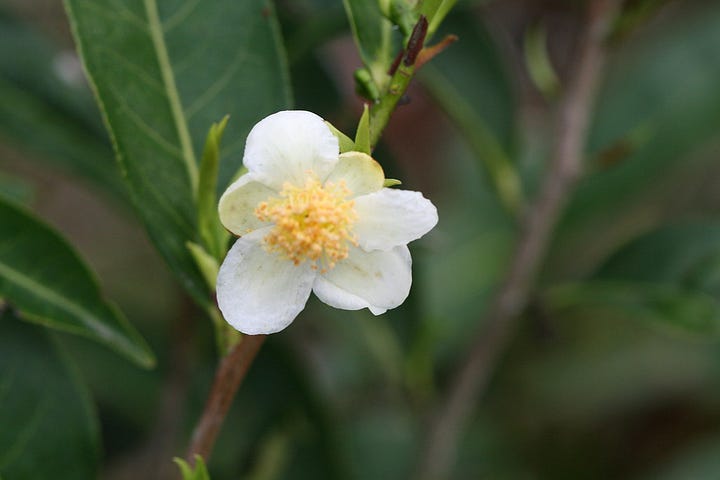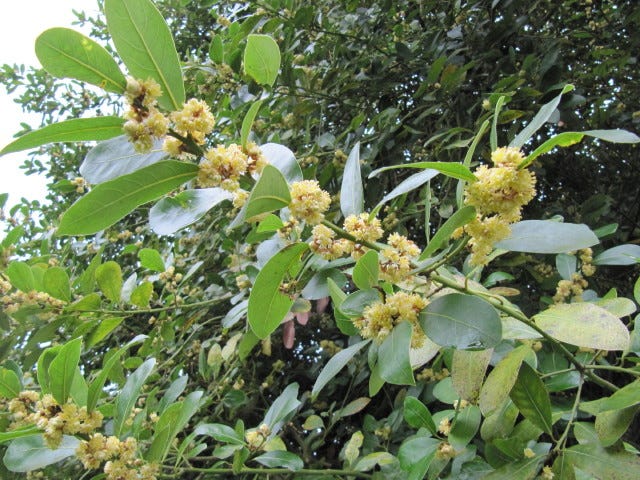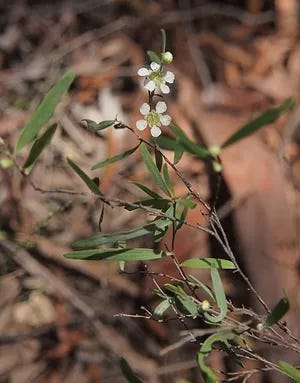ALSO KNOWN AS: Camellia Sinesis, chai, Ch’a, shay, çay, tsai, te, tee, thé
How to know:
Tiny white and sixish petaled flowers
Woody stalks… this is a shrub-tree plant.
Smooth leaves, shining leaves
Evergreen leaves the shape of almonds


Several thousand years ago the phenomenon of a particular kind of religion and philosophy happened around the Himalayan mountains. This was a conceptual discovery that defined a spirit who lived invisibly through the physical world, or even beyond the physical world. It was an energy that ran through all things. Taoism, Buddhism, Confucianism all emerged like thoughts out of the ether. Around the time these religions were being established in the world, people were beginning to drink the saturated water from the steamed vegetable once eaten in meals.
An Elevated State
Energy: a force welling up inside of us, a feeling that there is a deeper motivation or purpose: a movement in stillness. Too much and the world can feel like it's spinning, just enough and your attention is padded and centered like a sacred egg. This is what the perfect amount of caffeine feels like. Sure, caffeine is a drug and can be abused. But so can any plants. Plants have the ability to make us move in different ways depending on their chemistry - and ours. The caffeine in tea has a special touch. Tea leaves contain more caffeine than coffee beans, but the brewing process of coffee extracts more caffeine making it much stronger. The amino acid L-theanine that exists in tea takes longer for our body to process and so we don’t experience sharp highs and lows in tea intake.
Entire practices around the preparation and drinking of tea were organized throughout Asia and eventually were woven, too, into western culture. I am writing this very piece in a coffee shop, a place that is in direct lineage to the immense and continued impact of tea. This is a remnant of a sacred space where customs of harmonious congregation, work, and the acts of giving and receiving are performed.
6,000 years ago tea was steamed or blanched down like spinach and put into meals. So the tea was eaten long before it was made into a drink. The wild relative of tea is so old it might be more of a mix between different species.
Herbal teas are not teas at all, but tisane. A fact I didn’t know until I was well old. I thought tea was herbs steeped in hot water. Tea is, and will always be, the tea plant. In every language the word tea is very similar. The earliest form of the English “tea” is the word “chaa” which is likely from the Mandarin “Ch’a” or the Amoy dialect “T’e”. There is chai and te and çay. All of these terms for tea refer to the same plant.
This obscurity is perpetuated by the consumerism that has torn the tea plant away from its own identity. Green and black tea are split from their bodies and exoticized: one is given to Asia, the other to the West when in fact, they can be from the very same plant.
Every variation of white, black, yellow, and green tea are all representative of different parts and stages of the same plant. White tea is the buds of the plant. Green are its new leaves, harvested in the spring. Black tea is its mature emerald leaves late in the summer. Yellow tea is from a broad leaf, warmer climate tea species. And twig tea is exactly that: the tea plant’s twigs.
The plants are woody, and can grow into small trees. Their leaves shimmer with an evergreen gloss that keeps them sturdy through a range of temperatures, they are almond shaped and smooth all around the edges. The variety of tea native to the subtropical regions of the world have broader leaves, but as they were moved into more temperate regions they have adapted to have narrower leaves. The white flowers with six to eight petals that bloom in autumn are small with bursts of pollen filled stamens standing from their centers that dwarf the tiny petals and summon bees. In warm regions tea can be harvested twice a year. Tea plants have a single strong taproot that keeps them alive through inclement weather and in droughts.
A Plant of Legend
Shen Nung is the inventor of agriculture and medicinal herbs in Chinese mythology. He, as legend has it, taught people how to prepare tea. He was an emperor and a peasant, a man and a deity. Sometimes he has a bull head and is known in myth to have found the tea leaf by accident. Shen Nung is pictured chewing on leaves in a kind of scientific abandon as he experimented with each plant, observing his transparent stomach to see how his body would react to each like looking through a living microscope.
But his discovery of tea was not a result of wandering. He found tea as many human deities have found enlightenment or god: at the base of a tree. In some tellings he was very ill and in others he was boiling water when a tea leaf carried on the wind settled in his pot, or wedged itself into his feverish mouth and the tea was made.
In his book On Time and Water, Andri Snaer Magnuson talks about the sacred cow. A cow from which life was first nurtured. She is the glacial mountain. Her milk, the glacial stream. He masterfully describes this bovine mother feeding her young from mountains, whether it be Scandinavia or India. He makes the argument that this cow’s milk comes from the milk-white, mineral rich glacial runoff. Tea is said to be native to Assam, or the general region between the Himalayas and East into China. This region is known for its heat, humidity, and abundance of life, not to mention its ancient, rich mountains that feed that life. Growing in mountainous regions, tea is adapted to acidic soil, like blueberries. Though it can’t survive frost so it wreaths the subalpine like a crown. It seems intrinsically connected to the mountains, and so, if only mythically, connected to the minerals and sacred cow therein.
How much death and destruction has happened in the name of the trade of plants, from ebony to opium, and tea is one of them.
Tea was traded on the silk route and introduced to Europe by Portuguese monks. But the Dutch traders and the colonization period in Europe drove the tea trade to an extreme. Tea was so valuable that instead of paying with silver Britain proposed to trade the substance with opium, another plant, with another powerful effect. England went as far as to plan a covert operation to steal China’s tea so that they could plant and grow it in Darjeeling, India. Of course the implications of English empire and obsession for tea specifically have had disastrous consequences that continue to play out today.
There are hundreds of cultivars for tea specified for all different purposes. The Camellia genus itself has about 220 species and does not differentiate much between each other. They share their shrubbiness and their small flowers with thick petals and their glossy leaves, their fragrance and medicinal properties.
The tea plant has been used for so many cultural purposes that societies cannot be separated from it. Ethnobotanically, this plant is a medicinal plant above all. The Theaceae family contains calcium oxalate which creates that sharp flavor in tea. The polyphenols in the tea plant make it good to protect the skin against UV radiation, it can reduce the effects of arthritis. It has anti-inflammatory, anti-cancer, and anti-diabetic properties. Even though its tight winding branches can be trained into walls, I like to think they prefer the slopes of mountains.
Myth for tea
Forager Friendly?
There are not many wild tea plants, but if you find them, by all means, forage.
Not to be confused with bay leaf trees. These are trees, though their leaves are similar in their almond shape and they have clustered flowers along their branches.
Or tea tree. This is a tree with leaves that look almost like rosemary leaves, and it’s what tea tree oil is made of.
Sources:
https://www.kew.org/plants/tea-plant
https://www.youtube.com/watch?v=LaLvVc1sS20
https://assam.gov.in/about-us/398
On Time and Water, Andri Snær Magnason
How to Change Your Mind, Michael Pollan
Smoke and Ashes, Amitav Ghosh
https://www.sciencedirect.com/topics/agricultural-and-biological-sciences/camellia-sinensis#:~:text=14%20Camellia%20sinensis%20(family%3A%20Theaceae,evergreen%20shrub%20indigenous%20to%20Assam.
https://en.wikipedia.org/wiki/Camellia_sinensis
https://www.youtube.com/watch?v=ibqHrO33TvU
https://www.etymonline.com/search?q=tea







Tea, who warms me every morning. Tea, who calms the harsh winds of time. Tea, accompany me on the journey of life.